Technology of Dyeing beyond Text
Abstract
1. Introduction
2. Materials and Methods
2.1. Published Written and Iconographic Sources
2.2. Unpublished Written Sources
3. Results
3.1. Records Concerning Yellow/Orange Aprons
3.2. Orlean
3.3. Dyeing Experiments
3.3.1. Dyeing Experiment I
3.3.2. Dyeing Experiment II
4. Conclusions
Funding
Data Availability Statement
Acknowledgments
Conflicts of Interest
References
- Zeids, T. (Ed.) Johans Kristofs Broce un viņa darbs. In Johans Kristofs Broce. Zīmējumi un apraksti; Zinātne: Rīga, Latvia, 1992; Volume 1, pp. 8–27. ISBN 5-7966-0314-0. [Google Scholar]
- Johana Kristofa Broces Kolekcija “Sammlung Verschiedner Liefländischer Monumente …”. Available online: https://www.acadlib.lu.lv/broce/ (accessed on 13 February 2024).
- Jansons, A.J.K. Broces manuskripta “Sammlung verschiedner Liefländischer Monumente, Prospecte, Müntzen, Wapen etc.” apraksts. In Johans Kristofs Broce. Zīmējumi un apraksti; Zeids, T., Ed.; Zinātne: Rīga, Latvia, 1992; Volume 1, pp. 28–31. ISBN 5-7966-0314-0. [Google Scholar]
- Zeids, T. (Ed.) Johans Kristofs Broce. Zīmējumi un apraksti; Zinātne: Rīga, Latvia, 1992; Volume 1, ISBN 5-7966-0314-0. [Google Scholar]
- Zeids, T. (Ed.) Johans Kristofs Broce. Zīmējumi un apraksti; Zinātne: Rīga, Latvia, 1996; Volume 2, ISBN 5-7966-1017-1. [Google Scholar]
- Zeids, T.; Brambe, R.; Straube, G. (Eds.) Johans Kristofs Broce. Zīmējumi un apraksti; Rīga: Zinātne: Rīga, Latvia, 2002; Volume 3, ISBN 9984-698-01-7. [Google Scholar]
- Auns, M. (Ed.) Johans Kristofs Broce. Zīmējumi un apraksti; Latvijas Vēstures Institūta Apgāds: Rīga, Latvia, 2007; Volume 4, ISBN 9984-601-82-x. [Google Scholar]
- Sachen, die zu Verkaufen sind. Rigische Anzeigen, 1785, 44, p. 7. Available online: http://periodika.lv/periodika2-viewer/?lang=fr#issue:15418|article:DIVL56 (accessed on 15 February 2024).
- Sachen, die zu Verkaufen sind. Rigische Anzeigen, 1799, 9, p. 9. Available online: http://periodika.lv/periodika2-viewer/?lang=fr#issue:39153|article:DIVL82 (accessed on 15 February 2024).
- Sachen, die zu Verkaufen. Rigische Anzeigen, 1800, 10, p. 13 [119]. Available online: http://periodika.lv/periodika2-viewer/?lang=fr#issue:140499|article:DIVL114 (accessed on 15 February 2024).
- Sachen, die zu Verkaufen. Rigische Anzeigen, 1803, 26, p. 5 [305]. Available online: http://periodika.lv/periodika2-viewer/?lang=fr#issue:123241 (accessed on 15 February 2024).
- Sachen, die zu Verkaufen. Rigische Anzeigen, 1820, 25, p. 9. Available online: http://periodika.lv/periodika2-viewer/?lang=fr#issue:123610 (accessed on 15 February 2024).
- Auktionen. Rigasche Zeitung, 1811, 93, p. 3. Available online: http://periodika.lv/periodika2-viewer/?lang=fr#issue:36269 (accessed on 15 February 2024).
- Befehl an den Dirigirenden Senat. Verzeichniß Derjenigen Waaren, von Welchen ein Erhöhter Einfuhrzoll und Zulagsprocente von dem Zollrubel Erhoben Werden Müssen. Rigasche Zeitung, 1831, 144, p. 1. Available online: http://periodika.lv/periodika2-viewer/?lang=fr#issue:105504|article:DIVL68 (accessed on 15 February 2024).
- Ueber die Gemeine Harmala. Rigasche Zeitung, 1842, 74, p. 5. Available online: http://periodika.lv/periodika2-viewer/?lang=fr#issue:56691 (accessed on 15 February 2024).
- Inländische Nachrichten. Rigasche Zeitung, 1846, 138, p. 1. Available online: http://periodika.lv/periodika2-viewer/?lang=fr#issue:123365 (accessed on 19 February 2024).
- Specification der im 1809 ten Jahre in Riga Eingeführten Waaren. Rigasche Stadtblätter, 1810, 9, p. 3. Available online: http://periodika.lv/periodika2-viewer/?lang=fr#issue:156413|article:DIVL35 (accessed on 15 February 2024).
- Specification der im 1809 ten Jahre in Riga Eingeführten Waaren. Rigasche Stadtblätter, 1811, 1, p. 8. Available online: https://periodika.lndb.lv/periodika2-viewer/?lang=fr#issue:26181|article:DIVL123 (accessed on 15 February 2024).
- Specification der im 1811 ten Jahre in Riga Eingeführten Waaren. Rigasche Stadtblätter, 1812, 4, p. 2. Available online: http://periodika.lv/periodika2-viewer/?lang=fr#issue:152794|article:DIVL9 (accessed on 15 February 2024).
- Inland. Zuschauer, 1846, 5949, p. 1. Available online: http://periodika.lv/periodika2-viewer/?lang=fr#issue:323876 (accessed on 15 February 2024).
- Einfuhrwaren. Libausches Wochenblatt, 1846, 51. Available online: http://periodika.lv/periodika2-viewer/?lang=fr#issue:181652 (accessed on 19 February 2024).
- LNVM ZAE, 47: The National History Museum of Latvia, the ethnographic expedition materials of the Monuments Board, Dyeing, washing, bleaching, folder 47, collected in 1924–1942.
- LNVM ZAE, 35: The National History Museum of Latvia, the ethnographic expedition materials of the Monuments Board, Female folk dress, folder 35, collected in 1924–1942.
- Bielenstein, M. Die altlettischen Färbmethoden. Studien zur Indogermanischen Altertumskunde; Veröffentlichungen der volkskundlichen Forschungsstelle am Herderinstitut zu Riga; Ernst Plates: Riga, Latvia, 1935; Band 2. [Google Scholar]
- Cardon, D. Natural Dye: Sources, Tradition, Technology and Science; Archetype Publicatons: London, UK, 2007; pp. 312–317. ISBN 978-1-904982-00-5. [Google Scholar]
- Hofenk de Graaff, J.H. The Colourful Past: Origins, Chemistry and Identification of Natural Dyestuffs; Abegg-Stiftung and Archetype Publications Ltd.: London, UK, 2004; pp. 166–170. [Google Scholar]
- Bosco Violin Supply Home Page. Available online: https://www.boscoviolinsupply.com/en/category/makers-supplies/varnish-supplies/colour-extract-natural-dyes/1753 (accessed on 15 February 2024).
- Böhmer, H. Koekboya. Natural Dyes and Textiles: A Colour Jorney from Turkey to India and Beyond; REMHÖB: Gandrekesee, Germany, 2002; pp. 193, 262; ISBN 978-3936713015. [Google Scholar]
- Satyanayana, A.; Prabhakara Rao, P.G.; Rao, D.G. Chemistry, Processing and Toxicology of Annatto (Bixa orellana L.). J. Food Sci. Technol. 2003, 40, 131–141. Available online: https://www.researchgate.net/publication/287555602_Chemistry_Processing_and_Toxicology_of_Annatto_Bixa_orellana_L (accessed on 25 March 2024).
- Frankel, N. Dyeing with Annatto-Orange You Glad I Hate Cheesy Puns? In Textile Investigations. 3 October 2015. Available online: https://textileinvestigations.wordpress.com/2015/10/03/dyeing-with-annatto-orange-you-glad-i-hate-cheesy-puns/ (accessed on 15 February 2024).
- Karnups, Ā. Latviešu tērps pēdējos 350 gados. In Ievads latviešu Tautas Tērpu Vēsturē; Dzērvītis, A., Ģinters, V., Eds.; J. Grīnbergs: Rīga, Latvia, 1936; p. 147. [Google Scholar]
- Schweppe, H. Handbuch der Naturfarbstoffe: Vorkommen, Verwendung, Nachweis; Nikol Verlagsgesellschaft: Landsberg/Lech, Germany, 1993. [Google Scholar]
- LNVM ZAE 47, Smilšu krāsa, Kuldīgas apr. Pampāļu pag. Birbeļu Tilkas m., [bez teic.], 1929. g.
- Karlsone, A. The Tradition of Using Natural Dyes in Latvia. In Dyes in History and Archaeology; Jo Kirby, J., Ed.; Archetype Publications: London, UK, 2021; Volume 35/36, pp. 62–69. ISBN 9781909492813. [Google Scholar]

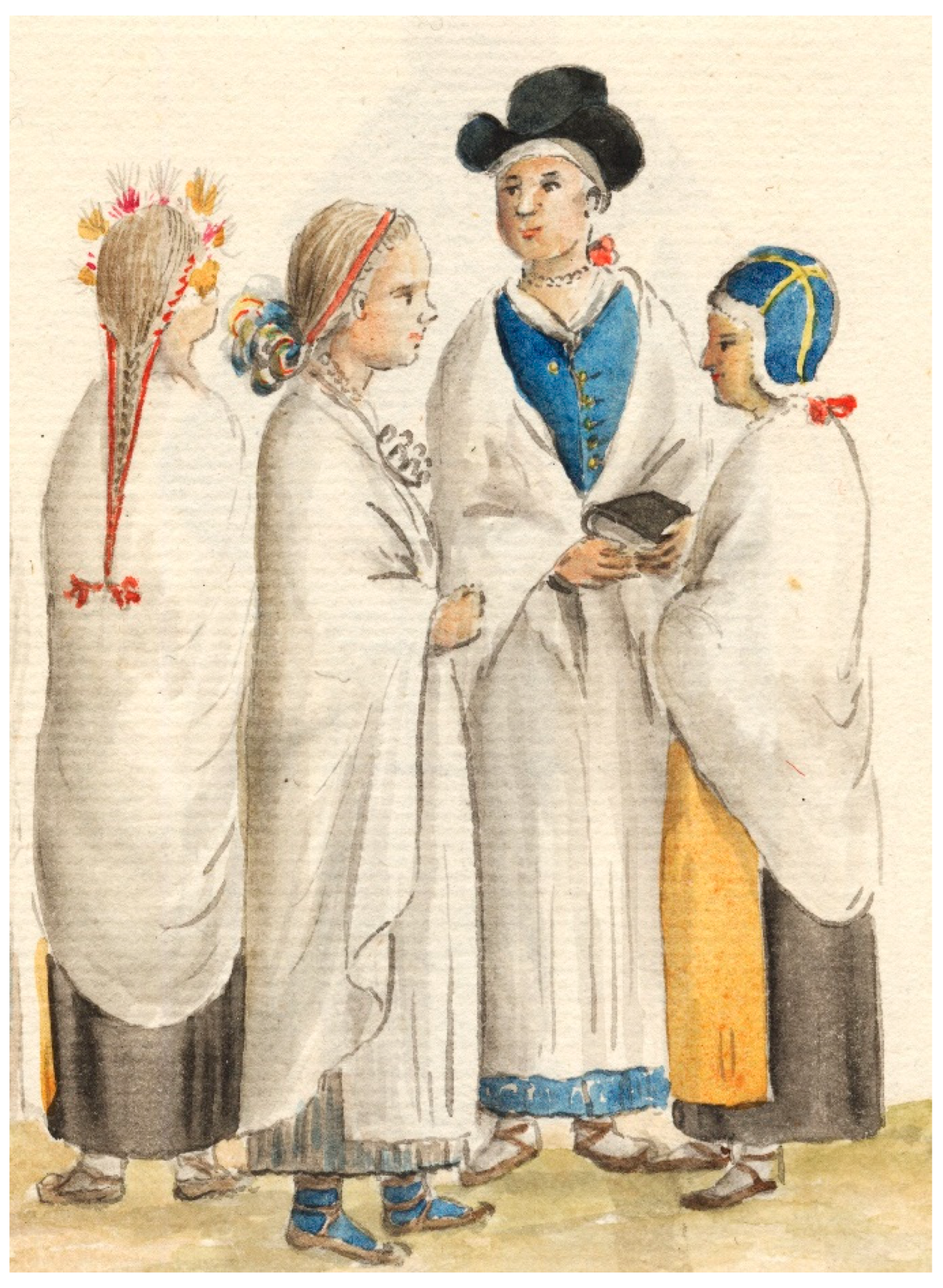
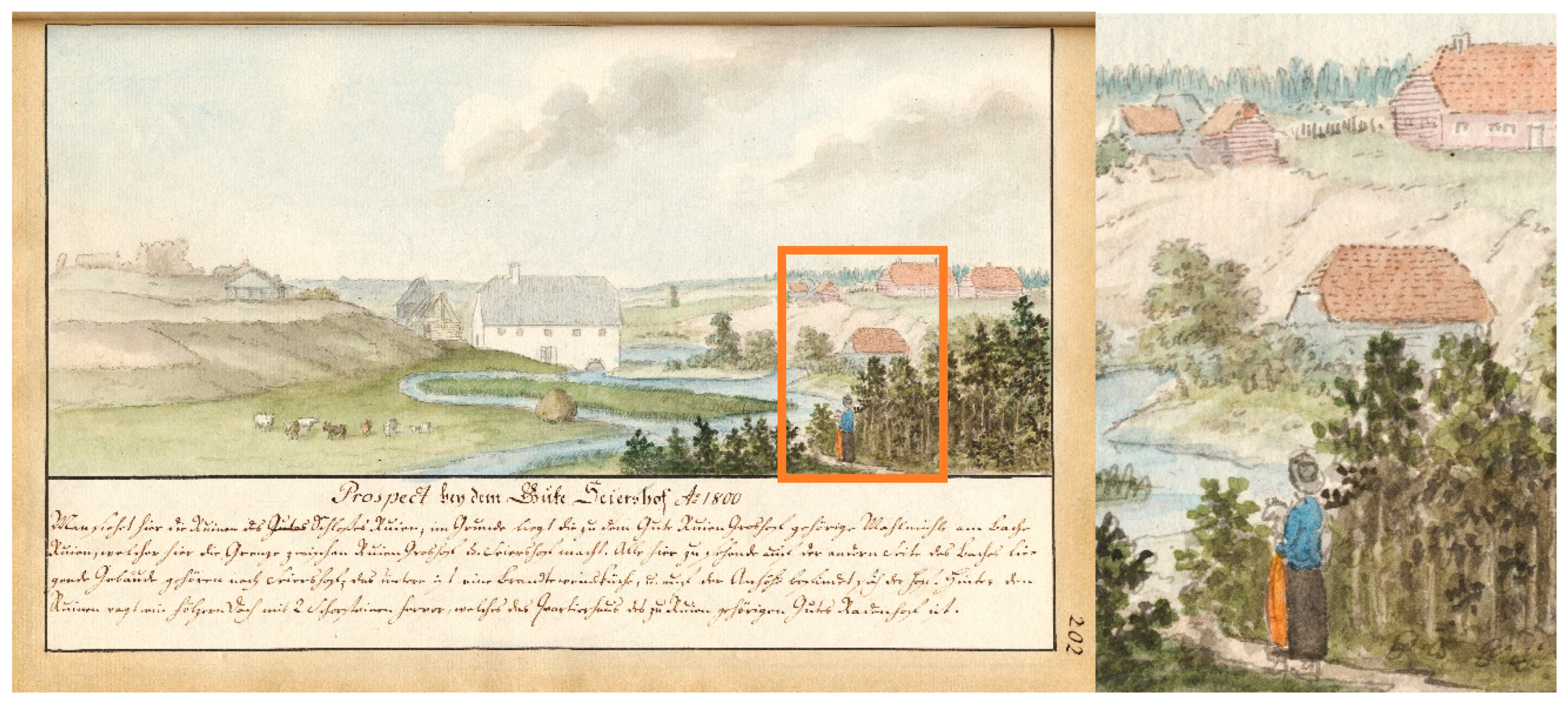
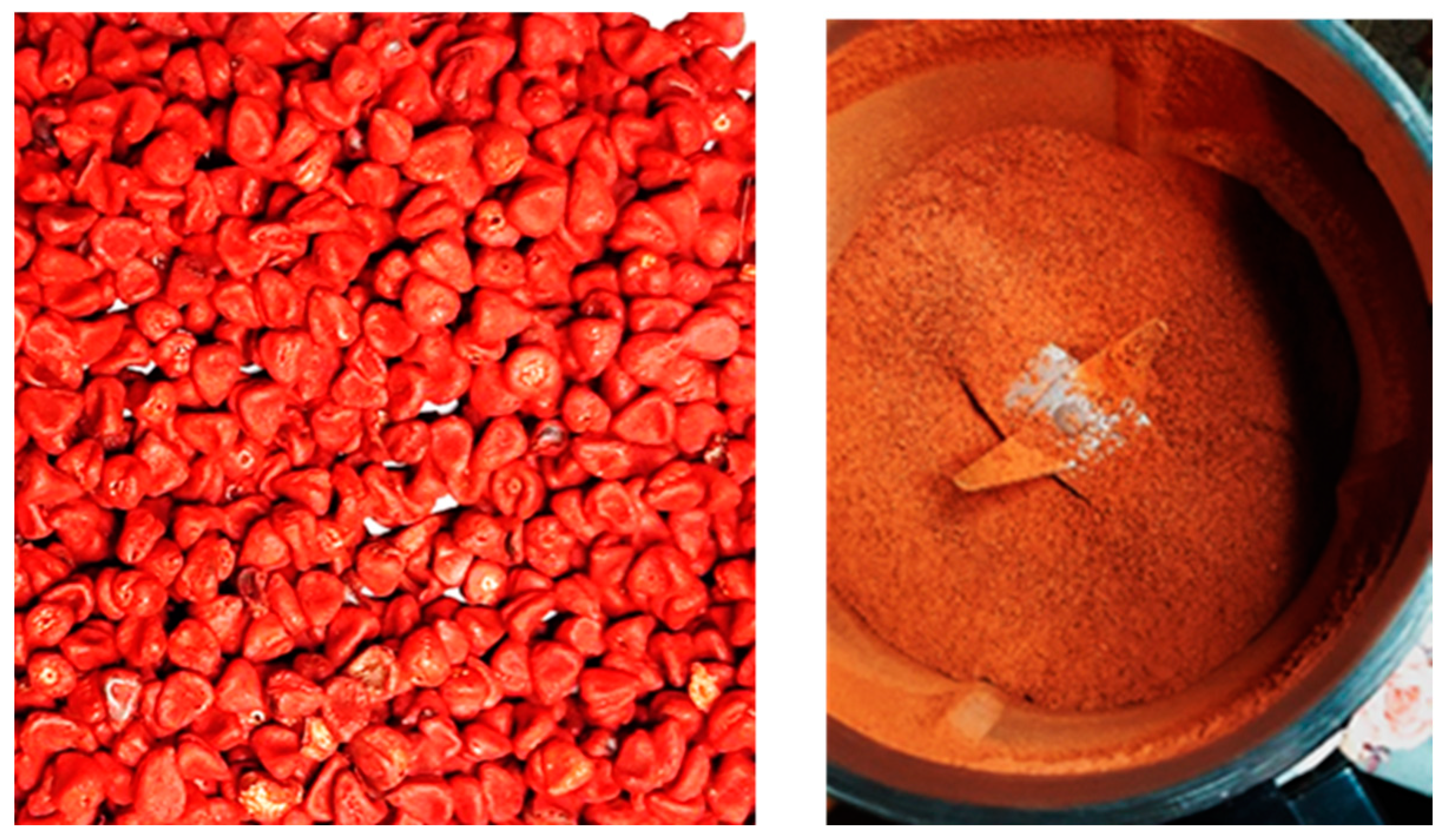
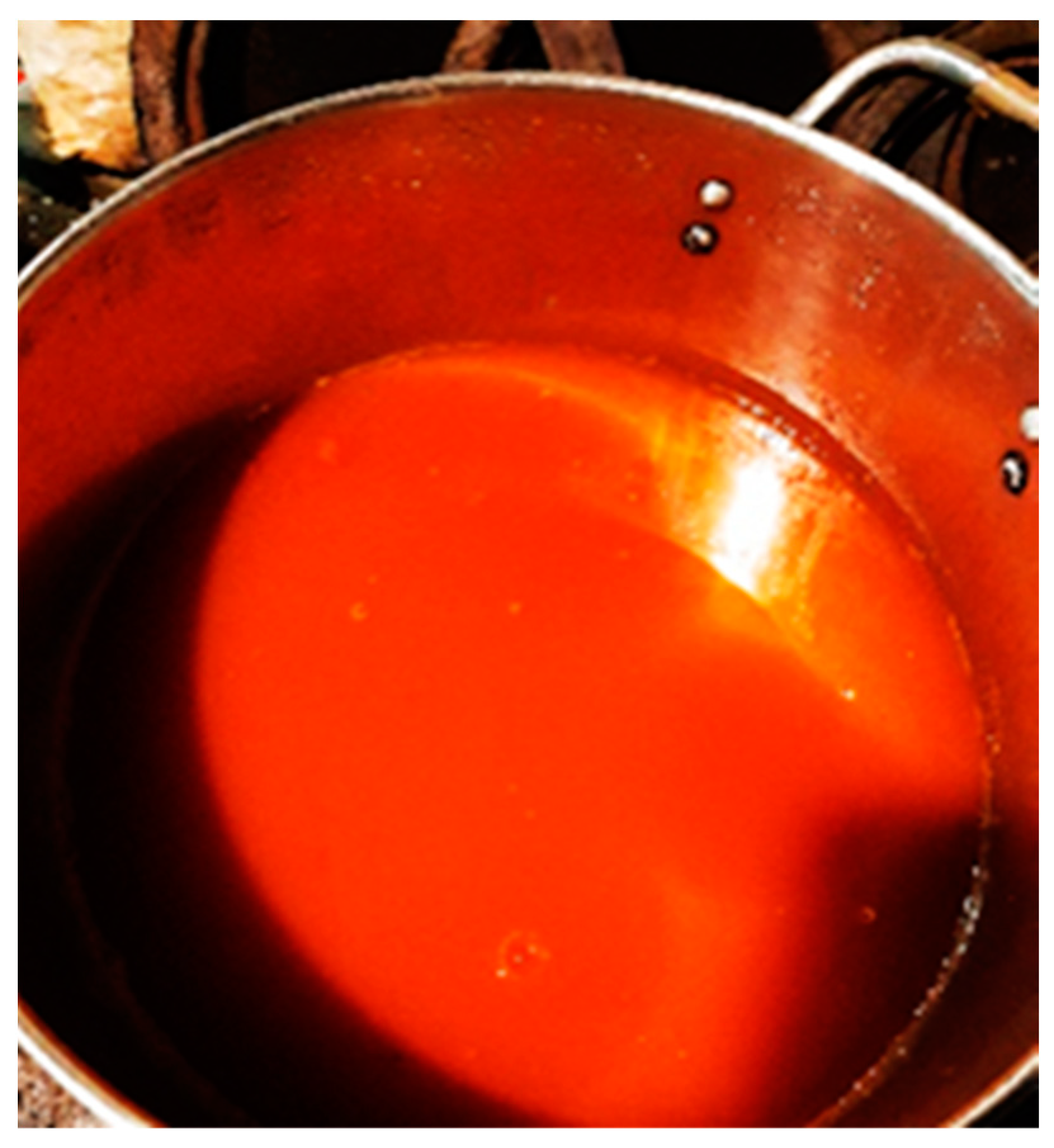
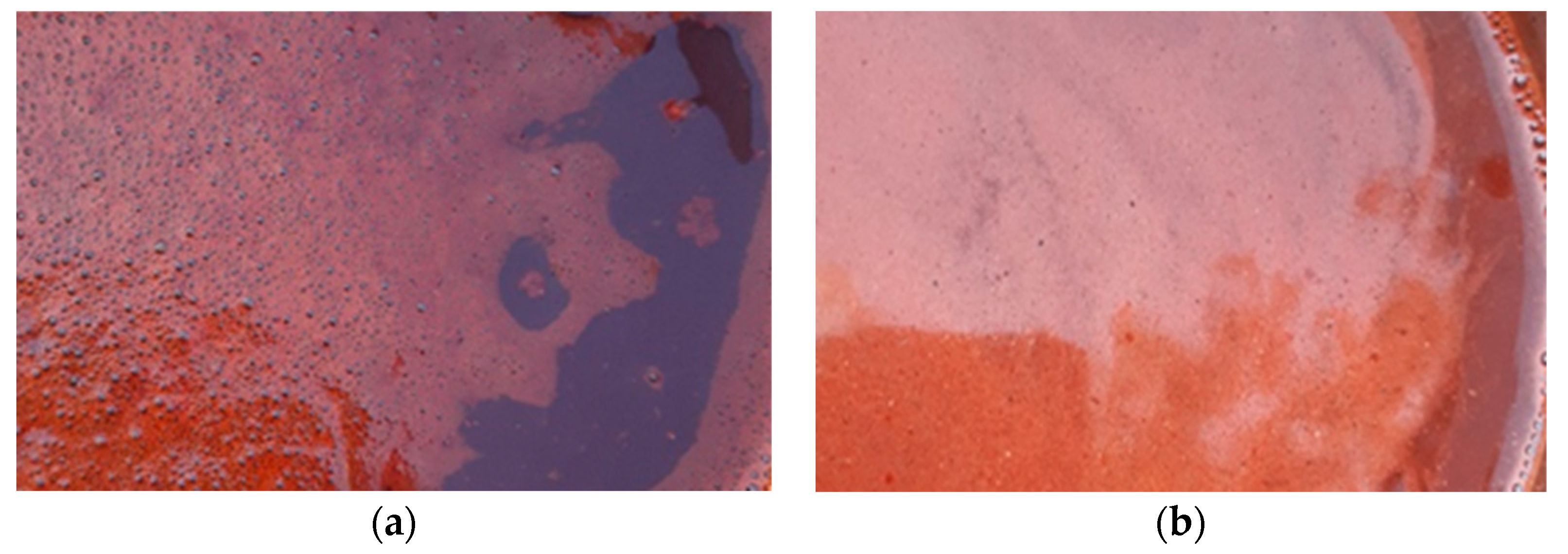
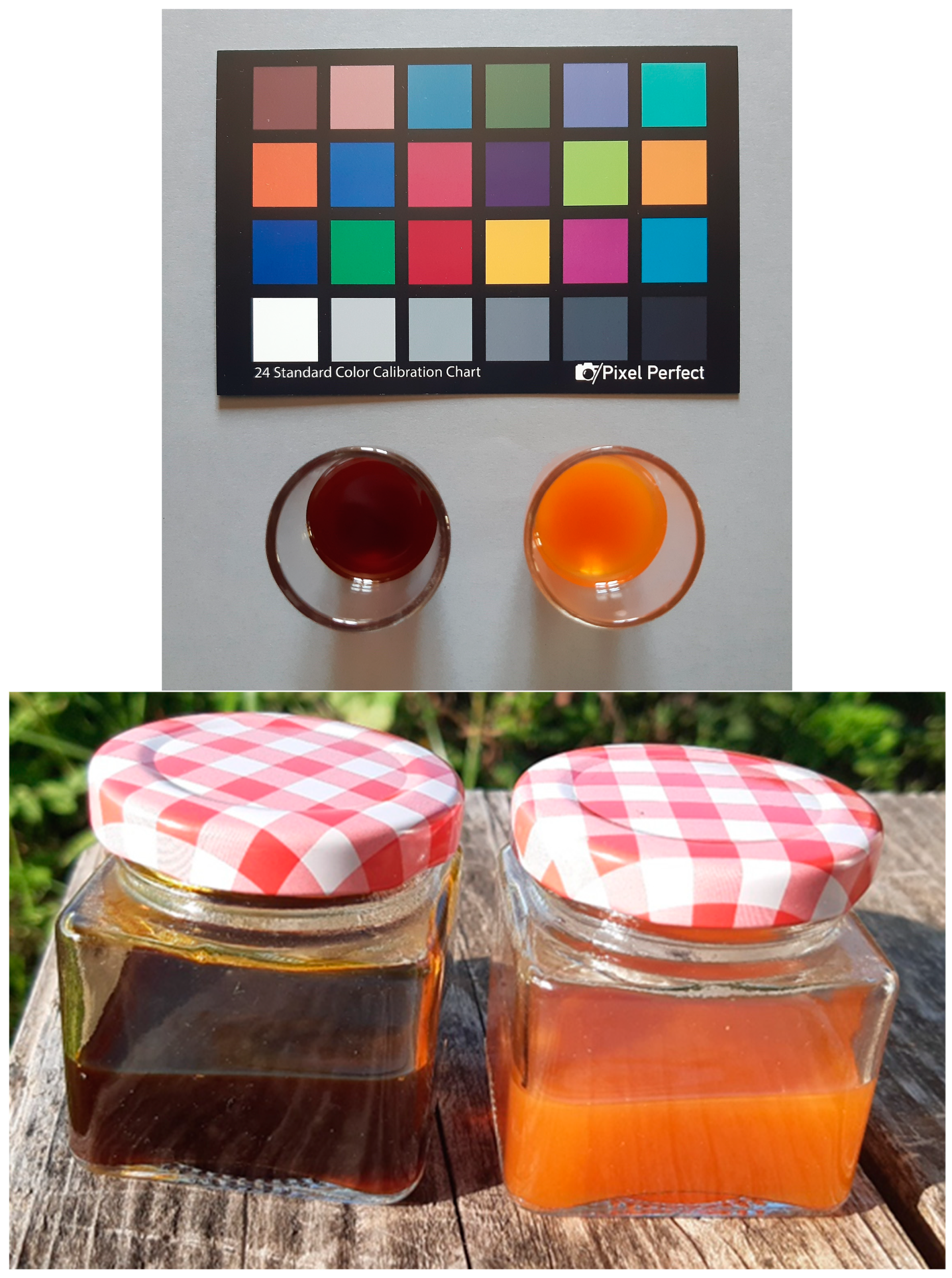
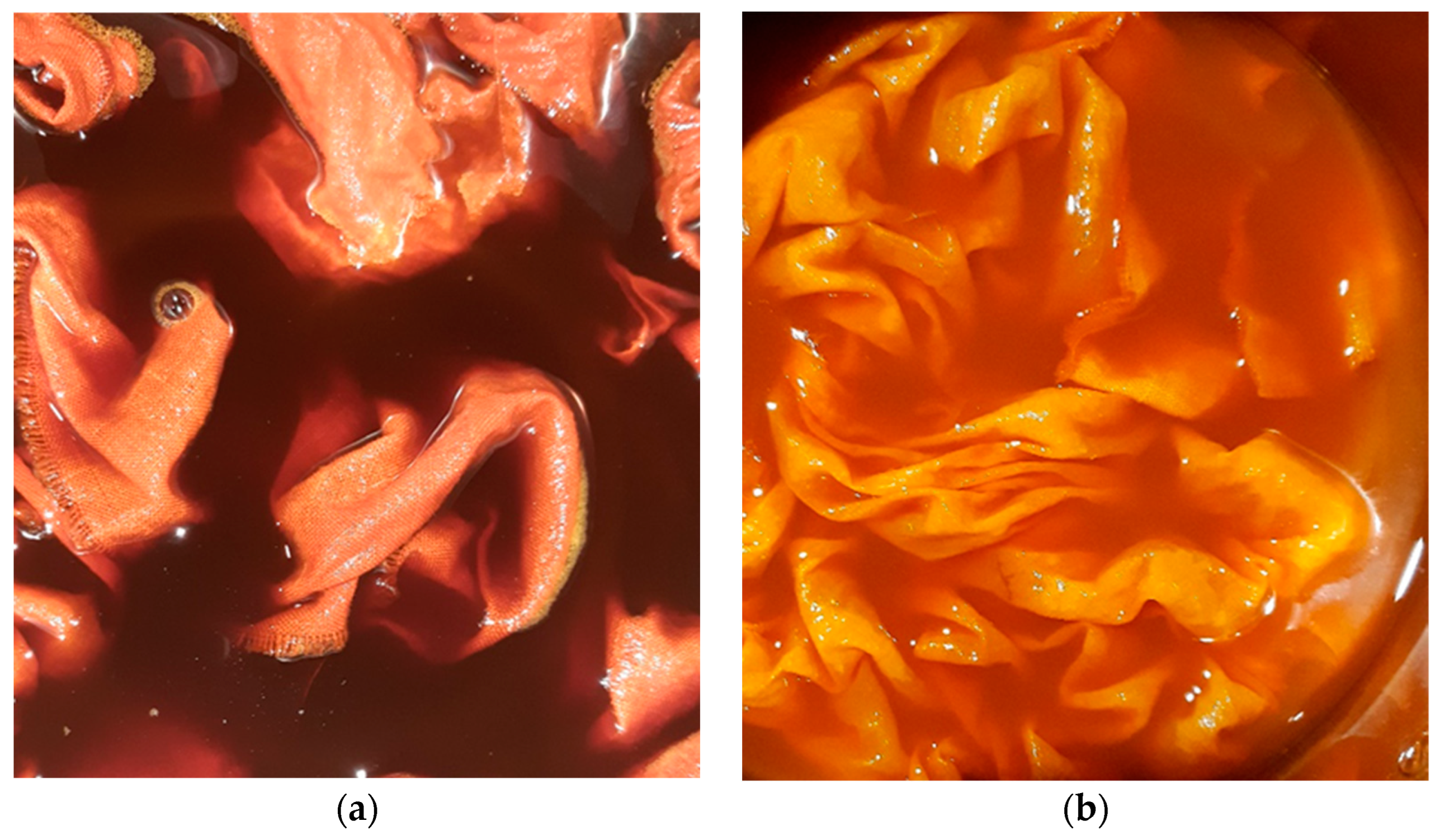
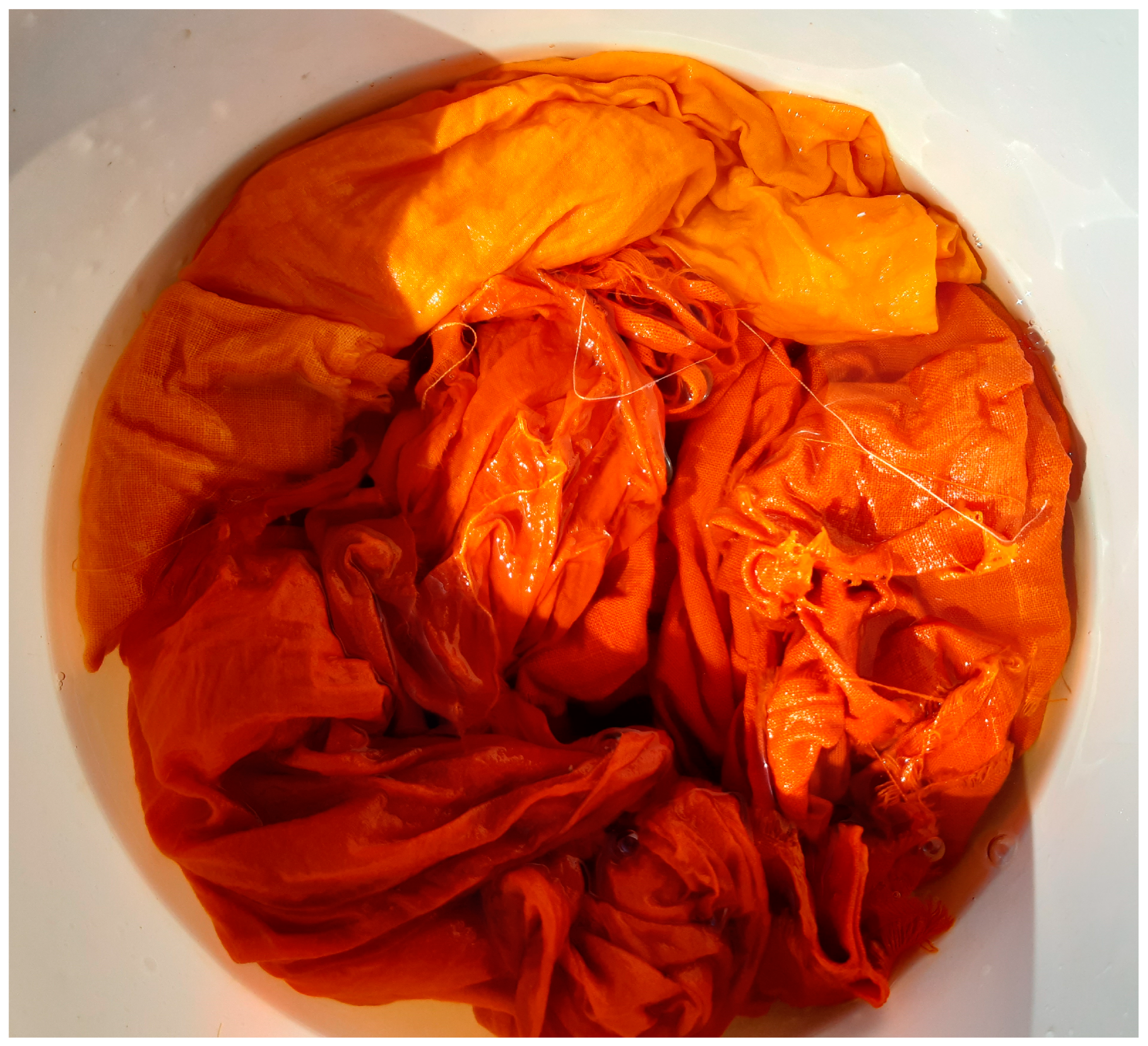

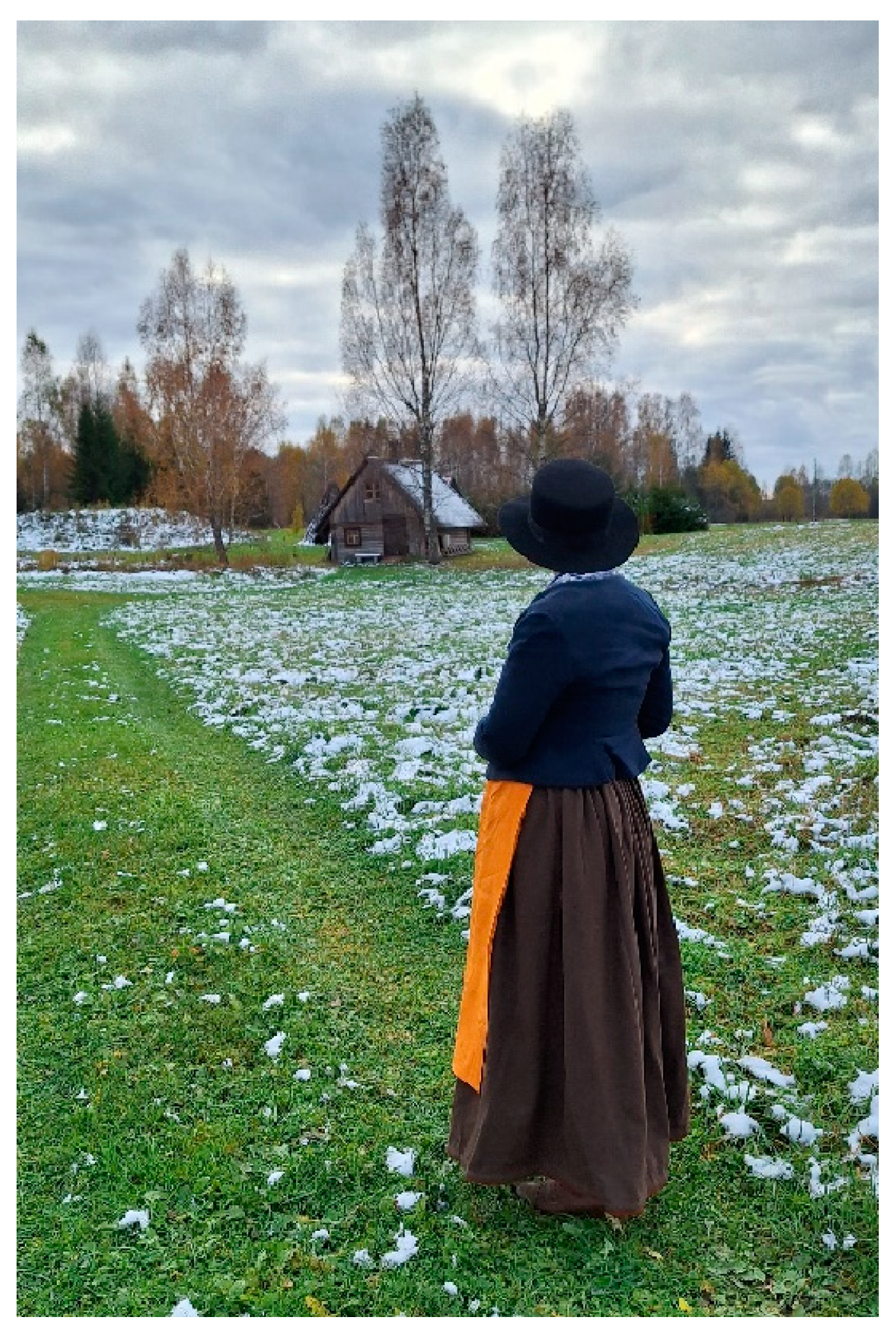
| Year | Dyestuff/Farben | Amount (Pounds) | Sources |
|---|---|---|---|
| 1809 | Cochenille | 4642 | Specification der im 1809 ten Jahre in Riga eingeführten Waaren. Rigasche Stadtblätter, 1810, 9, p. 3. [17] |
| Indigo | 50,630 ¾ | ||
| Orlean | 14,189 ½ | ||
| 1810 | Cochenille | 7456 ½ | Specification der im 1810 ten Jahre in Riga eingeführten Waaren. Rigasche Stadtblätter, 1811, 1, p. 8. [18] |
| Indigo | 11,569 ½ | ||
| Orlean | 3105 | ||
| Kurkumma | 25,061 ½ | ||
| 1811 | Indigo | 57,596 ½ | Specification der im 1811 ten Jahre in Riga eingeführten Waaren. Rigasche Stadtblätter, 1812, 4, p. 2. [19] |
| Orlean | 29,403 | ||
| Kurkumma | 5666 ½ |
| Dyed in Plain Water with Heating | Modified with Alkaline Solution (Lye) | |
|---|---|---|
| Wool without mordant |  |  |
| Wool mordanted with alum |  | |
 |  | |
| Linen mordanted with alum |  |  |
 |  | |
| Cotton mordanted with alum |  |  |
Disclaimer/Publisher’s Note: The statements, opinions and data contained in all publications are solely those of the individual author(s) and contributor(s) and not of MDPI and/or the editor(s). MDPI and/or the editor(s) disclaim responsibility for any injury to people or property resulting from any ideas, methods, instructions or products referred to in the content. |
© 2024 by the author. Licensee MDPI, Basel, Switzerland. This article is an open access article distributed under the terms and conditions of the Creative Commons Attribution (CC BY) license (https://creativecommons.org/licenses/by/4.0/).
Share and Cite
Karlsone, A. Technology of Dyeing beyond Text. Heritage 2024, 7, 2668-2681. https://doi.org/10.3390/heritage7060127
Karlsone A. Technology of Dyeing beyond Text. Heritage. 2024; 7(6):2668-2681. https://doi.org/10.3390/heritage7060127
Chicago/Turabian StyleKarlsone, Anete. 2024. "Technology of Dyeing beyond Text" Heritage 7, no. 6: 2668-2681. https://doi.org/10.3390/heritage7060127
APA StyleKarlsone, A. (2024). Technology of Dyeing beyond Text. Heritage, 7(6), 2668-2681. https://doi.org/10.3390/heritage7060127










